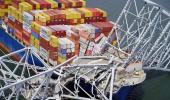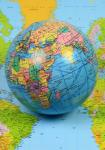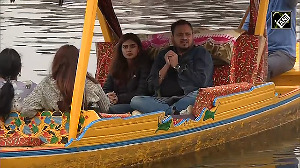'I can feel the master's pain, because he must be sitting there and cursing and saying, 'Why was I born?''

Ever since he got the news of the MV Dali's collision with the iconic, 47-year-old Francis Scott Key bridge in Baltimore harbour, Captain Peter Jhanjee has been rivetedly tracking subsequent developments on television from his home in Virginia.
Though he now works as vice president operations and strategic growth, for a US technology solutions company, former Mumbaikar Captain Jhanjee once guided ships as large as the South Korea-built, nine-year-old Dali, loaded with freight, across the world.
And what happened at 1.28 am on March 26, on the Patapsco river, took him back many years to his days as a master and to the nightmares of captaining a large freighter under a bridge.
The Francis Scott Key bridge accident was the disaster all captains pray does not befall them, because crossing under a bridge is always tricky, especially a continuous truss, older-style bridge equipped with none of the protective measures to prevent calamitous collisions and crumpling collapses that newer bridges are safeguarded against.
The Dali collision might very well become sadly the maritime disaster with greatest insurance payout ultimately.
Captain Jhanjee, after earning his bachelor of science in maritime operations at the Australian Maritime College, Tasmania, began his career with the Shipping Corporation of India in 1972.
He retired several years ago from the merchant navy, as a master for the Dole shipping firm, after 25 years of life at sea.
While much has changed since his day, Captain Jhanjee offers insights, based on his experience, to Vaihayasi Pande Daniel/Rediff.com on what might have occurred aboard the 1,000-foot ship that cold night, one hour after it left bustling Baltimore port.
The first of a multi-part interview:

When you first saw the visuals and heard about the crash, as someone who has vast experience in shipping, what was your reaction? What were some of questions that immediately popped into your head before the theory building and speculation began?
My first impression was that there was a power failure and that the ship had lost its steering. That was exactly what I thought.
Secondly, when I reviewed the footage the second time, I saw that there was a big puff of smoke from the chimney stack.
There can be various reasons for that puff of smoke. It could be just the exhaust being let off, which was one theory.
The smoke was a larger puff than usual. I questioned it in my mind: Was there an explosion or something else had taken place?
Then the emergency lights came on and shortly afterwards the emergency lights diminished again. So, all this went through my mind immediately -- power failure, loss of steering, and loss of propulsion.
The ship was already underway. I don't know what the river and tidal current situation was at that time.
Was it a strong current?
Was it an ebb flow?
What was happening with the tide?
How was it affecting the ship?
Reading, later on, I found that the ship was at eight knots, which is a pretty healthy speed.
Why was the speed that much? Was it because it had to counteract some of the current that was coming at it?
Or was that normal speed for a ship that was outward bound in a channel with hopefully very little traffic.

Your first reaction?
It was shock. I have driven over that bridge quite often by car. Then a lot of my thoughts were going out to the captain and chief engineer.
When you are underway in local waters, you have pilots on board -- one pilot or two. The pilot is supposed to be the local knowledge and take you through everything. But what should be noted, they are there to only offer advice.
What is logged in the logbook is that the ship is on master's orders and pilot's advice. The master is finally responsible for anything that happens to the ship.

You immediately felt for the master?
Oh, absolutely. But my first thought, being a master myself, or an ex-master/retired master, always goes to the master because there are a lot of things in close quarters that you have no control of. You are at the mercy of the winds and the elements.
Initially my thoughts were for the master, and as the story developed, there was a chief engineer involved as well, for him too.
I don't know how the situation is in the United States, but they may be behind bars for a little while until things are sorted out or they may be under house arrest and not allowed to move without security.
And I don't know how much the various companies themselves (owners, charterers and management) will actually support the captain and the chief engineer, because now all the inspections and liabilities etc will come into play and everyone will have to fend for themselves. We have to see what happens.

What could be possibly the fate of the ship and its crew and would this involve a much larger insurance pay out than is typical given it took down a whole long bridge?
Oh my God. Yeah. I can feel the master's pain, because he must be sitting there and cursing and saying, 'Why was I born?'
Yes, the insurance is going to be very big. It's going to be a big payout compared to other insurances payouts in such situations across the world.
This is going to be very, very large. I think I read somewhere that the largest one prior to this was about $600 million (the Costa Concordia disaster is so far the worst maritime disaster and before that was the Titanic).
I think this will cross the billion dollar mark. It was a chartered ship. It was run by a management company that had its local offices in the United States. It was operated by a third company. All of these people are going to have some sort of insurance involved. All of them will have a piece of the pie.
Then you have the shore side of things. There was loss of life -- six people lost their lives. How are they going to be compensated?
The bridge itself, they are talking about $600 million, (initial estimate). And it's going to take a lot of time, so then there's loss of wages, there's loss of revenue for the port. All of that has to be taken into account because somebody's going to claim all this.
The insurance companies are going to make a killing. A lot of lives are going to be affected.
- PART II: 'Indian crews are very good'
Feature Presentation: Ashish Narsale/Rediff.com











 © 2025
© 2025